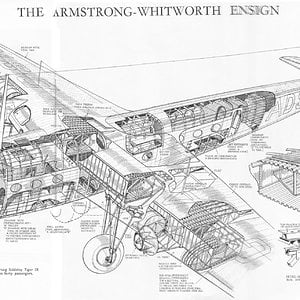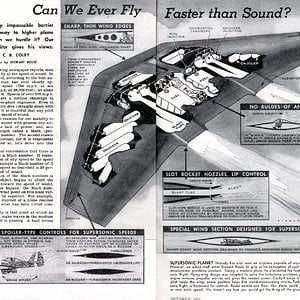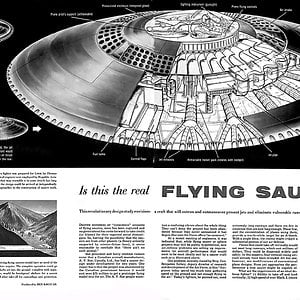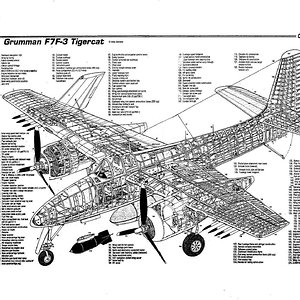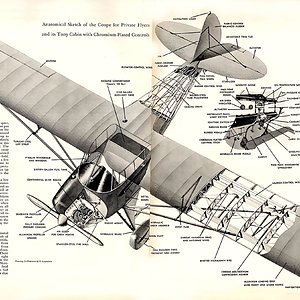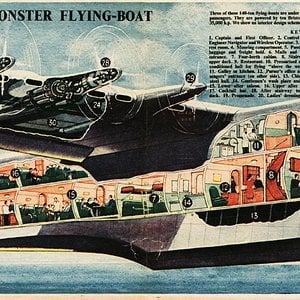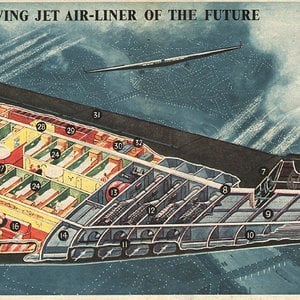Navigation
Install the app
How to install the app on iOS
Follow along with the video below to see how to install our site as a web app on your home screen.
Note: This feature may not be available in some browsers.
More options
You are using an out of date browser. It may not display this or other websites correctly.
You should upgrade or use an alternative browser.
You should upgrade or use an alternative browser.
Design and developmentBased on the earlier Grumman XP-50 that eventually was canceled, the company further developed the XP-65 (Model 51) for a future "convoy fighter" concept. In 1943, work on the XP-65 was terminated in favor of the design that would eventually become the F7F.[1] The contract for the prototype XF7F-1 was signed on 30 June 1941. Grumman's aim was to produce a fighter that out-performed and out-gunned all existing fighter aircraft, and that had an auxiliary ground attack capability.[2] Armament was heavy: four 20 mm cannons and four 0.50 in (12.7 mm) machine guns, as well as underwing and under-fuselage hardpoints for bombs and torpedoes. Performance met expectations too; the F7F Tigercat was one of the highest performance piston-engined fighters, with a top speed well in excess of the US Navy's single-engined aircraft—71 mph faster than a F6F Hellcat at sea level.[3] Capt. Fred M. Trapnell, one of the Navy's premier test pilots, opined that: "It's the best damn fighter I've ever flown."[4] The Grumman F7F was originally named the "Tomcat" but this name was rejected as it was considered too suggestive, at the time.[5] The name would much later be used for the Grumman F-14.
An F7F-3N of VMF(N)-513 at Wonsan, Korea, in 1952.All this was bought at the cost of heavy weight and a high landing speed, but what caused the aircraft to fail carrier suitability trials was poor directional stability with only one engine operational, as well as problems with the tail-hook design.[6] Therefore, the initial production series was only used from land bases by the USMC, as night fighters with APS-6 radar.[7] At first, they were single-seater F7F-1N aircraft, but after the 34th production aircraft, a second seat for a radar operator was added; these aircraft were designated F7F-2N.
The next version produced, the F7F-3 was modified to correct the issues that caused the aircraft to fail carrier acceptance and this version was again trialled on the USS Shangri-La (CV-38). A wing failure on a heavy landing caused the failure of this carrier qualification too. F7F-3 aircraft were produced in day fighter, night fighter and photo-reconnaissance versions.[8]
A final version, the F7F-4N, was extensively rebuilt for additional strength and stability, and did pass carrier qualification, but only 12 were built.[8]
Specifications (F7F-4N Tigercat)
Drawing of an F7F-3N.Data from Jane's Fighting Aircraft of World War II[25]
General characteristics
Crew: 2 (pilot, radar operator)
Length: 45 ft 4 in (13.8 m)
Wingspan: 51 ft 6 in (15.7 m)
Height: 16 ft 7 in (5.1 m)
Wing area: 455 ft² (42.3 m²)
Empty weight: 16,270 lb (7,380 kg)
Max takeoff weight: 25,720 lb (11,670 kg)
Powerplant: 2 × Pratt & Whitney R-2800-34W "Double Wasp" radial engines, 2,100 hp (1,566 kW) each
Performance
Maximum speed: 460 mph (400 knots, 740 km/h)
Range: 1,200 mi (1,000 nmi, 1,900 km)
Service ceiling: 40,400 ft (12,300 m)
Rate of climb: 4,530 ft/min (1,381 m/min)
Armament
Guns:
4 × 20 mm (0.79 in) M2 cannon
4 × 0.50 in (12.7 mm) M2 Browning machine gun
Bombs:
2 × 1,000 lb (454 kg) bombs under wings or
1 × torpedo under fuselage
Avionics
AN/APS-19 radar
An F7F-3N of VMF(N)-513 at Wonsan, Korea, in 1952.All this was bought at the cost of heavy weight and a high landing speed, but what caused the aircraft to fail carrier suitability trials was poor directional stability with only one engine operational, as well as problems with the tail-hook design.[6] Therefore, the initial production series was only used from land bases by the USMC, as night fighters with APS-6 radar.[7] At first, they were single-seater F7F-1N aircraft, but after the 34th production aircraft, a second seat for a radar operator was added; these aircraft were designated F7F-2N.
The next version produced, the F7F-3 was modified to correct the issues that caused the aircraft to fail carrier acceptance and this version was again trialled on the USS Shangri-La (CV-38). A wing failure on a heavy landing caused the failure of this carrier qualification too. F7F-3 aircraft were produced in day fighter, night fighter and photo-reconnaissance versions.[8]
A final version, the F7F-4N, was extensively rebuilt for additional strength and stability, and did pass carrier qualification, but only 12 were built.[8]
Specifications (F7F-4N Tigercat)
Drawing of an F7F-3N.Data from Jane's Fighting Aircraft of World War II[25]
General characteristics
Crew: 2 (pilot, radar operator)
Length: 45 ft 4 in (13.8 m)
Wingspan: 51 ft 6 in (15.7 m)
Height: 16 ft 7 in (5.1 m)
Wing area: 455 ft² (42.3 m²)
Empty weight: 16,270 lb (7,380 kg)
Max takeoff weight: 25,720 lb (11,670 kg)
Powerplant: 2 × Pratt & Whitney R-2800-34W "Double Wasp" radial engines, 2,100 hp (1,566 kW) each
Performance
Maximum speed: 460 mph (400 knots, 740 km/h)
Range: 1,200 mi (1,000 nmi, 1,900 km)
Service ceiling: 40,400 ft (12,300 m)
Rate of climb: 4,530 ft/min (1,381 m/min)
Armament
Guns:
4 × 20 mm (0.79 in) M2 cannon
4 × 0.50 in (12.7 mm) M2 Browning machine gun
Bombs:
2 × 1,000 lb (454 kg) bombs under wings or
1 × torpedo under fuselage
Avionics
AN/APS-19 radar


